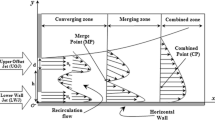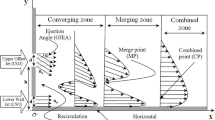Abstract
The present numerical work reports the efficacy of jet obliquity \((\phi )\) on turbulent flow and thermal characteristics of offset jet. Moreover, the effects of variation in Reynolds number (Re) and offset ratio (OR) on different heat transfer and flow parameters of oblique offset jet have also been presented in this paper. The performances of different models of turbulence have been tested against the various experimental results for study of offset jet flow. The Reynolds number of flow and offset ratio are considered in the range of \(Re=10000-25000\) and \(OR=3-11\), respectively. The obliquity angle of offset jet is varied in the range \(\phi =90^{0}-45^{0}\) at an interval of \(15^{0}\). The detailed study of heat transfer from impingement wall has been done by considering either the isoflux or the isothermal boundary condition on the heated wall. The changes in turbulent flow pattern of offset jet due to the influence of different parameters are represented in terms of velocity magnitude contour with streamline curvature, jet reattachment length, center of vortex, distribution profiles of longitudinal \(U-\)velocity and skin friction coefficient, similarity solution and contours of longitudinal U and transverse V velocities etc.; whereas the changes in thermal behaviour are addressed in the form of local and average Nusselt number, wall temperature and wall heat flux variation plots. The exhaustive parametric study of oblique offset jet flow reveals the fact that the process of heat transfer from heated impingement wall to fluid is more intense for higher value of jet obliquity angle and Reynolds number, for lower value of offset ratio and for isoflux boundary condition. The findings of present invstigation can be used as a tool for better design and utilization of heating or cooling jets in material processing, metal, electronics and automobile industries.



























Similar content being viewed by others
Data availability
Not applicable.
Code availability
Software application (ANSYS-FLUENT).
Abbreviations
- H :
-
Distance between bottom impingement wall and nozzle mid-point, m
- k :
-
Turbulent kinetic energy, \(m^{2}\, s^{-2}\)
- L :
-
Length of impingement wall, m
- \(Nu_{avg}\) :
-
Average Nusselt number
- \(Nu_{x}\) :
-
Local Nusselt number
- \(Pr, Pr_{t}\) :
-
Laminar and turbulent Prandtl number, respectively
- \(q_{w}\) :
-
Wall heat flux, \(Wm^{-2}\)
- Re :
-
Reynolds number, \(\rho u_{0}w/\mu\)
- T :
-
Temperature, K
- \(T_{w}\) :
-
Wall temperature, K
- U, V :
-
Dimensionless longitudinal and transverse velocities, respectively, \(U=u/{u_{0}},V=v/{u_{0}}\)
- u, v :
-
Longitudinal and transverse velocities, respectively, \(m\, s^{-1}\)
- \(u_{\tau }\) :
-
Friction velocity, \(\sqrt{\tau _{w}/\rho }\), \(m\, s^{-1}\)
- \(U_{max}\) :
-
Dimensionless maximum longitudinal velocity, \({u_{max}}/{u_{0}}\)
- \(u_{max}\) :
-
Maximum longitudinal velocity, \(m\, s^{-1}\)
- w :
-
Nozzle width, m
- X, Y :
-
Dimensionless longitudinal and transverse coordinates, respectively, \(X=x/w,Y=y/w\)
- x, y :
-
Longitudinal and transverse coordinates, respectively, m
- \(X_{rp}\) :
-
Dimensionless reattachment length, \(x_{rp}/w\)
- \(x_{rp}\) :
-
Reattachment length, m
- \(y^{+}\) :
-
Dimensionless distance, \(yu_{\tau }\rho /\mu\)
- \(Y_{0.5}\) :
-
Dimensionlessl distance in Y-direction, where \(U=U_{max}/2\)
- \({p_{a}}\) :
-
Ambient pressure, Pa
- p :
-
Static pressure, Pa
- \({u_{0}}\) :
-
Jet inlet velocity, \(m\, s^{-1}\)
- \(\epsilon\) :
-
Dissipation rate, \(m^{2}\, s^{-3}\)
- \(\mu ,\,\mu _{t}\) :
-
Laminar and turbulent dynamic viscosity, respectively, \(kg\, m^{-1}\, s^{-1}\)
- \(\omega\) :
-
Specific dissipation rate, \(s^{-1}\)
- \(\phi\) :
-
Jet inclination or obliquity angle
- \(\rho\) :
-
Fluid density, \(kg\, m^{-3}\)
- \(\tau _{w}\) :
-
Wall shear stress, Pa
- \(C_{fx}\) :
-
Skin friction coefficient, \(\tau _{w}/\frac{1}{2}\rho u_{0}^{2}\)
- max :
-
Maximum
- n :
-
Dimensionless quantity
- vc :
-
Vortex center
References
Pelfrey JRR, Liburdy JA (1986) Mean flow characteristics of a turbulent offset jet. Transaction ASME Journal of Fluids Engineering 108:82–88
Anderson EA, Spall RE (2001) Experimental and numerical investigation of two-dimensional parallel jets. Transaction ASME Journal of Fluids Engineering 123:401–406
Vishnuvardhanarao E, Das MK (2008) Computation of mean flow and thermal characteristics of incompressible turbulent offset jet flows. Numerical Heat Transfer, Part A: Applications 53(8):843–869
Pramanik S, Das MK (2013) Numerical characterization of a planar turbulent offset jet over an oblique wall. Comput Fluids 77:36–55
Rathore SK, Das MK (2016) Effect of freestream motion on heat transfer characteristics of turbulent offset jet. Journal of Thermal Science and Engineering Applications, ASME 8:011021–1
Rathore SK (2019) Study of conjugate heat transfer from heated plate by turbulent offset jet in presence of freestream motion using low-reynolds number modeling. Journal of Applied Fluid Mechanics 12:617–630
Singh TP, Kumar A, Satapathy AK (2019a) Fluid flow analysis of a turbulent offset jet impinging on a wavy wall surface. Proc IMechE Part C: J Mechanical Engineering Science 0(0):1–20
Singh TP, Kumar A, Satapathy AK (2020a) Heat transfer and fluid flow characteristics of a turbulent dual jet impinging on a wavy surface. Journal of Thermal Science and Engineering Applications, ASME 12:041017–1
Behera VM, Rathore SK (2021) Numerical investigation of turbulent offset jet flow over a moving flat plate using low-Reynolds number turbulence model. Journal of Thermal Science and Engineering Applications, ASME 13:051005–1
Tritton DJ (1977) Physical Fluid Dynamics. Von Norstrand Reinhold, UK, pp 284–286
Bourque C, Newman BG (1960) Reattachment of two-dimensional incompressible jet to an adjacent flat plate. Aeronaut Q 11:201–232
Sawyer RA (1960) The flow due to a two-dimensional jet issuing parallel to a flat plate. J Fluid Mech 9:543–559
Sawyer RA (1963) Two-dimensional reattaching jet flows including the effects of curvature on entrainment. J Fluid Mech 17:481–498
Hoch J, Jiji LM (1981a) Two-dimensional turbulent offset jet-boundary interaction. Transaction ASME Journal of Fluid Engineering 103:154–161
Hoch J, Jiji LM (1981b) Theoretical and experimental temperature distribution in two-dimensional turbulent jet-boundary interaction. Transaction ASME Journal of Heat Transfer 103:331–335
Holland JT, Liburdy JA (1990) Measurements of the thermal characteristics of heated offset jets. Int J Heat Mass Transf 33(1):69–78
Nasr A, Lai JCS (1998) A turbulent plane offset jet with small offset ratio. Exp Fluids 24:47–57
Song HB, Yoon SH, Lee DH (2000) Flow and heat transfer characteristics of a two-dimensional oblique wall attaching offset jet. Int J Heat Mass Transf 43:2395–2404
Vishnuvardhanarao E, Das MK (2009) Conjugate heat transfer study of incompressible turbulent offset jet flows. Heat Mass Transf 45:1141–1152
Chaab MA, Tachie M (2011) Characteristics and structure of turbulent 3d offset jets. Int J Heat Fluid Flow 32:608–620
Rathore SK, Das MK (2013) Comparison of two low-reynolds number turbulence models for fluid flow study of wall bounded jets. Int J Heat Mass Transf 61:365–380
Rathore SK, Das MK (2015) A comparative study of heat transfer characteristics of wall-bounded jets using different turbulence models. Int J Therm Sci 89:337–356
Assoudi A, Habli S, Said NM, Bournot H, Palec GL (2015) Experimental and numerical study of an offset jet with different velocity and offset ratios. Engineering Applications of Computational Fluid Mechanics 9:1:490–512
Assoudi A, Habli S, Said NM, Bournot H, Palec GL (2016) Three-dimensional study of turbulent flow characteristics of an offset plane jet with variable density. Heat Mass Transf 52:2327–2343
Mohammadaliha N, Afshin H, Farahanieh B (2016) Numerical investigation of nozzle geometry effect on turbulent 3-d water offset jet flows. Journal of Applied Fluid Mechanics 9:2083–2095
Assoudi A, Said NM, Bournot H, Palec GL (2018) Comparative study of flow characteristics of a single offset jet and a turbulent dual jet. Heat Mass Transf 55:1109–1131
Launder BE, Spalding DB (1974) The numerical computation of turbulent flows. Comput Methods Appl Mech Eng 3:269–289
ANSYS (2016) ANSYS FLUENT Theory Guide V. 17.2. ANSYS Inc
Patankar SV (1980) Numerical Heat Transfer and Fluid Flow. Hemisphere, New York
Kumar A, Das MK (2011) Study of a turbulent dual jet consisting of a wall jet and an offset jet. Transaction ASME Journal of Fluids Engineering 133(10):101201 (11)
Kumar A (2015) Mean flow and thermal characteristics of a turbulent dual jet consisting of a plane wall jet and a parallel offset jet. Numerical Heat Transfer, Part A: Applications 67(10):1075–1096
Singh TP, Kumar A, Satapathy AK (2019b) Numerical study to enhance the heat transfer using sinusoidal wavy surface for turbulent wall jet. Numerical Heat Transfer, Part A: Applications 77:179–198
Singh TP, Kumar A, Satapathy AK (2021) Role of a sinusoidal wavy surface in enhancement of heat transfer using turbulent dual jet. Journal of Heat Transfer, ASME 143(3):032002–1
Wygnanski I, Katz Y, Horev E (1992) On the applicability of various scaling laws to the turbulent wall jet. J Fluid Mech 234:669–690
Rathore SS, Verma SK (2021) A comparative study of fluid flow characteristics of dual jet using different rans based turbulence models. Lecture Notes in Mechanical Engineering (Theoretical, Computational, and Experimental Solutions to Thermo-Fluid Systems). Springer, pp 355–365
Lai JCS, Nasr A (1998) Two parallel plane jets: comparison of the performance of three turbulence models. Proceedings of the Institution of Mechanical Engineers, Part G: Journal of Aerospace Engineering 212(6):379–391
Mondal T, Das MK, Guha A (2016) Transition of a steady to a periodically unsteady flow for various jet widths of a combined wall jet and offset jet. Transaction ASME Journal of Fluids Engineering 138:070907–1 (11)
Singh TP, Kumar A, Satapathy AK (2020b) Enhancement of heat transfer using turbulent wall jet. Proc IMechE Part E: J Process Mechanical Engineering 234(1):123–136
Singh TP, Kumar A, Satapathy AK (2020c) Effect of wavy wall surface on flow structure and thermal characteristics of a turbulent dual jet comprising of a wall jet and an offset jet. Proc IMechE Part A: J Power and Energy 0(0):1–22
Author information
Authors and Affiliations
Corresponding authors
Ethics declarations
Conflicts of interest
On behalf of all authors, the corresponding author states that there is no conflict of interest.
Additional information
Publisher’s Note
Springer Nature remains neutral with regard to jurisdictional claims in published maps and institutional affiliations.
Rights and permissions
About this article
Cite this article
Rathore, S.S., Verma, S.K. Numerical investigation on the efficacy of jet obliquity for fluid flow and thermal characteristics of turbulent offset jet. Heat Mass Transfer 58, 1223–1246 (2022). https://doi.org/10.1007/s00231-021-03156-0
Received:
Accepted:
Published:
Issue Date:
DOI: https://doi.org/10.1007/s00231-021-03156-0




